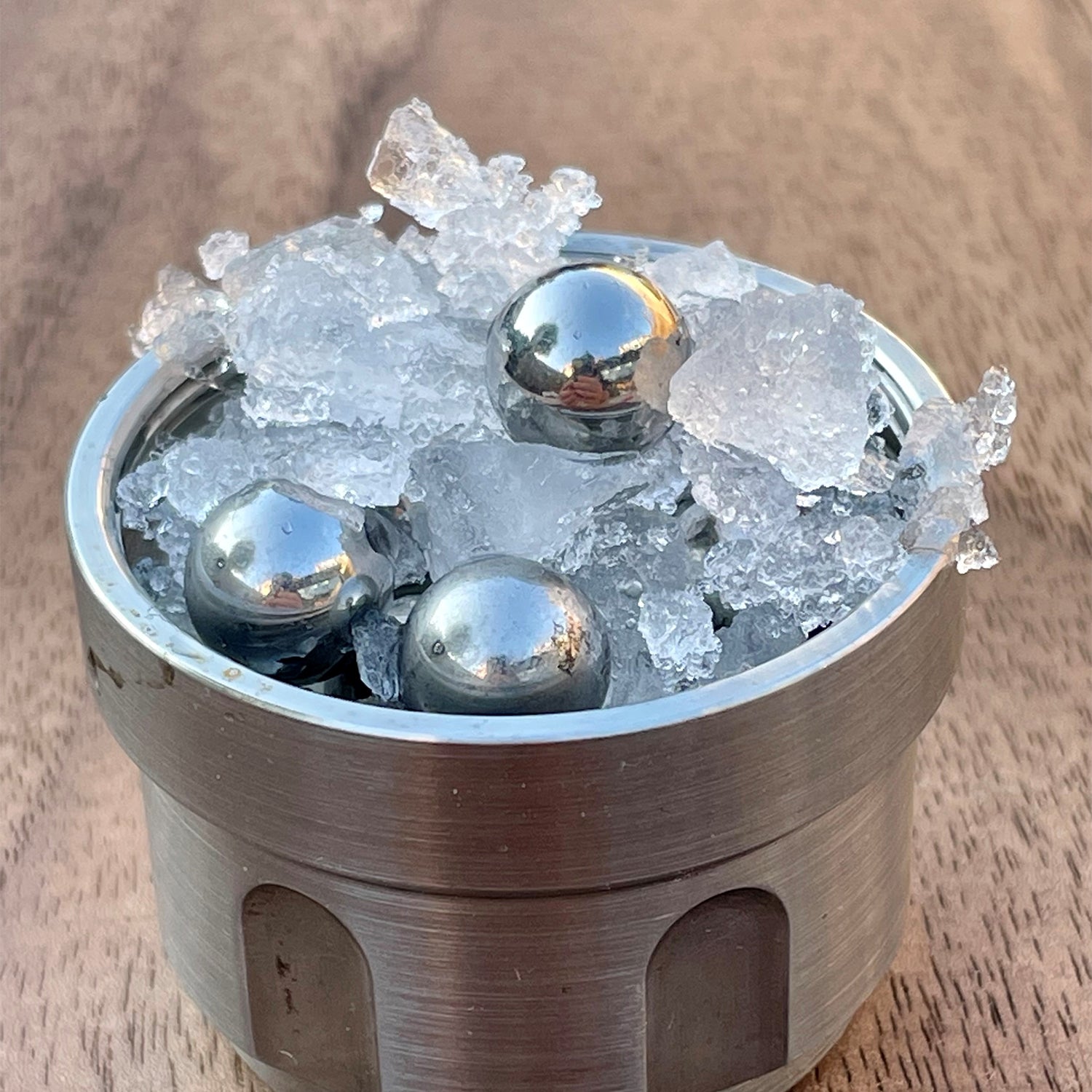
Scientists have created a new type of ice that matches the density and structure of water, perhaps opening a door to studying water’s mysterious properties.
“It might be liquid water frozen in time,” says Martin Chaplin, a specialist in water structure at London South Bank University, who was not involved in the work. “It could be very important.”
The ice is called medium-density amorphous ice. The team that created it, led by Alexander Rosu-Finsen at University College London (UCL), shook regular ice in a small container with centimetre-wide stainless-steel balls at temperatures of –200 ˚C to produce the variant, which has never been seen before. The ice appeared as a white granular powder that stuck to the metal balls. The findings were published today in Science1.
Haphazard molecules
Normally, when water freezes, it crystallizes and its molecules are arranged into the familiar hexagonal, solid structure that we call ice. Ice is less dense than its liquid form — an unusual property for a crystal. Depending on conditions such as pressure and the speed of freezing, water can also solidify in any of two dozen other regular arrangements. Amorphous ice is different: it has no such order. “You have lots of molecules joining on haphazardly,” says Chaplin.
Two types of amorphous ice have been previously discovered, both in the twentieth century. ‘Low-density’ amorphous ice is the result of water vapour freezing onto a very cold surface, at a temperature lower than –150 ˚C; ‘high-density’ amorphous ice forms by compressing ordinary ice at similar temperatures under high pressure. Although neither type is common on Earth, both are plentiful in space. “Comets are big chunks of low-density amorphous ice,” says Christoph Salzmann, a chemist at UCL and a co-author of the latest work.
The team used a ball mill, a tool normally used to grind or blend materials in mineral processing, to grind down crystallized ice. Using a container with metal balls inside, they shook a small amount of ice about 20 times per second. The metal balls produced a ‘shear force’ on the ice, says Salzmann, breaking it down into a white powder.
Firing X-rays at the powder and measuring them as they bounced off — a process known as X-ray diffraction — allowed the team to work out its structure. The ice had a molecular density similar to that of liquid water, with no apparent ordered structure to the molecules — meaning that crystallinity was “destroyed”, says Salzmann. “You’re looking at a very disordered material.”
The results are “pretty convincing”, says Marius Millot, a physicist at the Lawrence Livermore National Laboratory in California. “This is a great example of how we still have things to understand with water.”
The results matched models produced by scientists on the team at the University of Cambridge, UK, predicting what would happen if regular ice was broken down in this manner. It’s unclear, however, whether the resultant powder truly matches the properties of liquid water, given that it was previously frozen as crystallized ice. Investigating that will require further work.
Big implications
If confirmed, the new form of ice could enable studies of water in a manner that was not possible before. “Liquid water is a strange material,” says Chaplin. “We still don’t know as much about it as we’d like.” For example, it is commonly thought that water is composed of two forms, low-density and high-density water, matching the previously known variants of amorphous ice. The discovery of a medium-density amorphous ice could challenge that idea.
“If medium-density amorphous ice is really connected to liquid water, it would imply that this model is incorrect,” says Salzmann. “It could open up a new chapter in ice research.”
There are implications, too, for understanding other worlds. Some moons in our Solar System, such as Jupiter’s moon Europa and Saturn’s moon Enceladus, have icy surfaces. If two icy areas on such a moon were to rub together because of tidal forces, they could produce medium-density amorphous ice between them through the same shearing process that the researchers used.
The increase in density could create gaps in the surface, producing disruptions on the moons as the ice cracks together. “There would be a massive collapse of the ice,” says Salzmann. “It could have severe implications for the geophysics of the icy moons.”
That could, in turn, have implications for the potential habitability of liquid-water oceans that lie under the ice surfaces on these moons. “One of the key things about those moons is whether you can have an interface between liquid water and the rocks — this is where life could emerge,” says Millot. “Amorphous ice could have a role that we need to understand.”
This article is reproduced with permission and was first published on February 2 2023.
